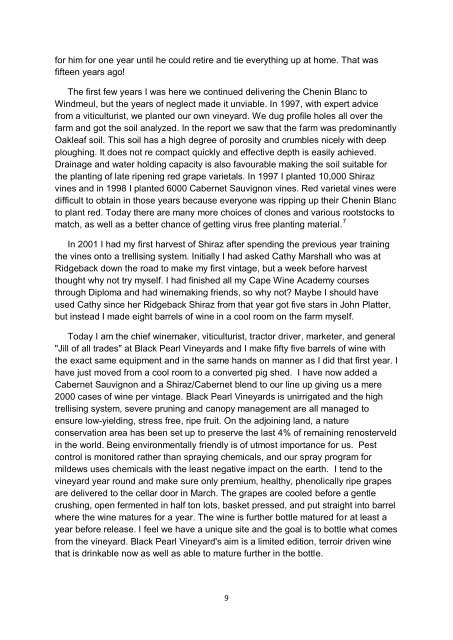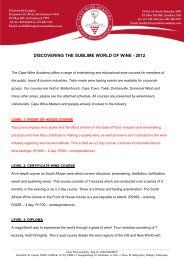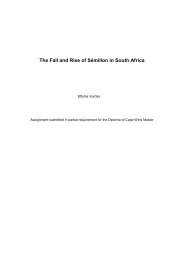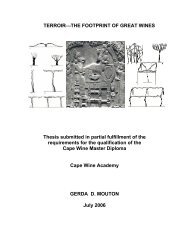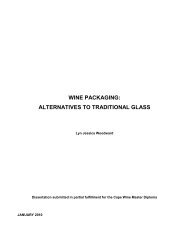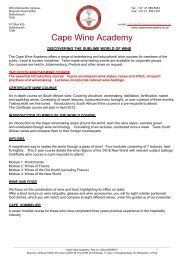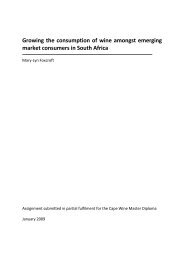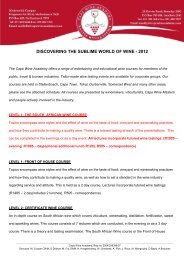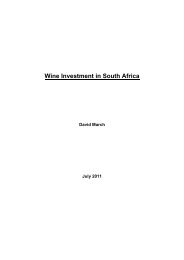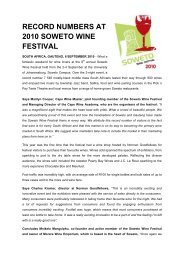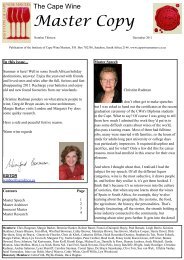Garage Winemaking in South Africa Less is More - Cape Wine ...
Garage Winemaking in South Africa Less is More - Cape Wine ...
Garage Winemaking in South Africa Less is More - Cape Wine ...
You also want an ePaper? Increase the reach of your titles
YUMPU automatically turns print PDFs into web optimized ePapers that Google loves.
for him for one year until he could retire and tie everyth<strong>in</strong>g up at home. That was<br />
fifteen years ago!<br />
The first few years I was here we cont<strong>in</strong>ued deliver<strong>in</strong>g the Chen<strong>in</strong> Blanc to<br />
W<strong>in</strong>dmeul, but the years of neglect made it unviable. In 1997, with expert advice<br />
from a viticultur<strong>is</strong>t, we planted our own v<strong>in</strong>eyard. We dug profile holes all over the<br />
farm and got the soil analyzed. In the report we saw that the farm was predom<strong>in</strong>antly<br />
Oakleaf soil. Th<strong>is</strong> soil has a high degree of porosity and crumbles nicely with deep<br />
plough<strong>in</strong>g. It does not re compact quickly and effective depth <strong>is</strong> easily achieved.<br />
Dra<strong>in</strong>age and water hold<strong>in</strong>g capacity <strong>is</strong> also favourable mak<strong>in</strong>g the soil suitable for<br />
the plant<strong>in</strong>g of late ripen<strong>in</strong>g red grape varietals. In 1997 I planted 10,000 Shiraz<br />
v<strong>in</strong>es and <strong>in</strong> 1998 I planted 6000 Cabernet Sauvignon v<strong>in</strong>es. Red varietal v<strong>in</strong>es were<br />
difficult to obta<strong>in</strong> <strong>in</strong> those years because everyone was ripp<strong>in</strong>g up their Chen<strong>in</strong> Blanc<br />
to plant red. Today there are many more choices of clones and various rootstocks to<br />
match, as well as a better chance of gett<strong>in</strong>g virus free plant<strong>in</strong>g material. 7<br />
In 2001 I had my first harvest of Shiraz after spend<strong>in</strong>g the previous year tra<strong>in</strong><strong>in</strong>g<br />
the v<strong>in</strong>es onto a trell<strong>is</strong><strong>in</strong>g system. Initially I had asked Cathy Marshall who was at<br />
Ridgeback down the road to make my first v<strong>in</strong>tage, but a week before harvest<br />
thought why not try myself. I had f<strong>in</strong><strong>is</strong>hed all my <strong>Cape</strong> W<strong>in</strong>e Academy courses<br />
through Diploma and had w<strong>in</strong>emak<strong>in</strong>g friends, so why not? Maybe I should have<br />
used Cathy s<strong>in</strong>ce her Ridgeback Shiraz from that year got five stars <strong>in</strong> John Platter,<br />
but <strong>in</strong>stead I made eight barrels of w<strong>in</strong>e <strong>in</strong> a cool room on the farm myself.<br />
Today I am the chief w<strong>in</strong>emaker, viticultur<strong>is</strong>t, tractor driver, marketer, and general<br />
"Jill of all trades" at Black Pearl V<strong>in</strong>eyards and I make fifty five barrels of w<strong>in</strong>e with<br />
the exact same equipment and <strong>in</strong> the same hands on manner as I did that first year. I<br />
have just moved from a cool room to a converted pig shed. I have now added a<br />
Cabernet Sauvignon and a Shiraz/Cabernet blend to our l<strong>in</strong>e up giv<strong>in</strong>g us a mere<br />
2000 cases of w<strong>in</strong>e per v<strong>in</strong>tage. Black Pearl V<strong>in</strong>eyards <strong>is</strong> unirrigated and the high<br />
trell<strong>is</strong><strong>in</strong>g system, severe prun<strong>in</strong>g and canopy management are all managed to<br />
ensure low-yield<strong>in</strong>g, stress free, ripe fruit. On the adjo<strong>in</strong><strong>in</strong>g land, a nature<br />
conservation area has been set up to preserve the last 4% of rema<strong>in</strong><strong>in</strong>g renosterveld<br />
<strong>in</strong> the world. Be<strong>in</strong>g environmentally friendly <strong>is</strong> of utmost importance for us. Pest<br />
control <strong>is</strong> monitored rather than spray<strong>in</strong>g chemicals, and our spray program for<br />
mildews uses chemicals with the least negative impact on the earth. I tend to the<br />
v<strong>in</strong>eyard year round and make sure only premium, healthy, phenolically ripe grapes<br />
are delivered to the cellar door <strong>in</strong> March. The grapes are cooled before a gentle<br />
crush<strong>in</strong>g, open fermented <strong>in</strong> half ton lots, basket pressed, and put straight <strong>in</strong>to barrel<br />
where the w<strong>in</strong>e matures for a year. The w<strong>in</strong>e <strong>is</strong> further bottle matured for at least a<br />
year before release. I feel we have a unique site and the goal <strong>is</strong> to bottle what comes<br />
from the v<strong>in</strong>eyard. Black Pearl V<strong>in</strong>eyard's aim <strong>is</strong> a limited edition, terroir driven w<strong>in</strong>e<br />
that <strong>is</strong> dr<strong>in</strong>kable now as well as able to mature further <strong>in</strong> the bottle.<br />
9


